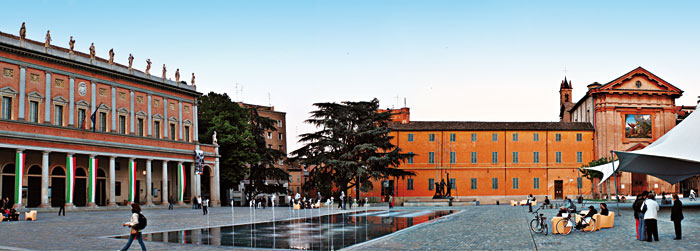The city of Reggio Emilia
Reggio Emilia, a European city
at the cutting edge of education,
auto mechanics and the food industry.

Reggio Emilia has a population of 164,000, while the entire province has approximately 510,000 inhabitants. It is a medium-sized city for Italian standards, making it enjoyable to visit and tour, particularly following the recent restructuring of its historical centre. Reggio Emilia is easy to get around on foot or by bicycle (thanks to an extensive network of cycling paths), and it is a place where one can enjoy nature and fresh air (thanks to its 31 parks). It abounds in world-class cultural activities, not normally found in a city of its size.
Reggio Emilia boasts three theatres offering top-class opera, concert and drama performances. The city is also home to a wide network of libraries, museums, galleries and cultural centres especially aimed at young people.
Today, Reggio Emilia is home to many ethnic groups and is becoming increasingly multicultural, with 11.4% of its population consisting of foreign residents. The city has one of the most advanced educational and social welfare systems in the country (and in Western Europe), considered one of the most innovative and relevant examples of a community with a strong social cohesion.
The province includes several towns of historical and cultural importance (such as Correggio and Scandiano) and has a beautiful countryside, with its gently sloping plains along the Po River, the Apennine mountains and several villages, all of which are popular destinations for excursions and vacations. For further information see the local tourist information website.
Reggio Emilia also boasts an illustrious history, including some of the great Italian literary figures of the fourteenth and fifteenth centuries from Ludovico Ariosto (to whom the Ariosto Theatre is dedicated) to Matteo Maria Boiardo. It was here that the Tricolour Italian Flag was proclaimed (a museum bearing the same name is located inside the Town Hall), in 1797, and became the symbol of the Cispadane Republic, the first republican political experiment in modern Italian history. This led to the creation, at the end of the 19th century, and again, following the Second World War, of one of the most advanced educational and social welfare systems in the country (and in Western Europe). It is considered as one of the most innovative and relevant examples of a community with strong social cohesion.
